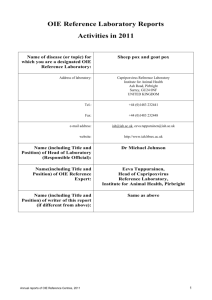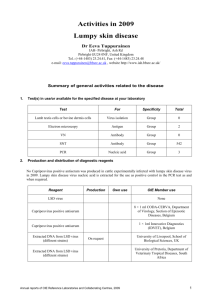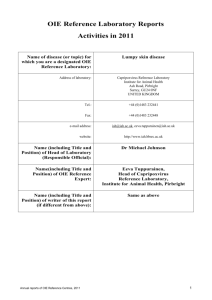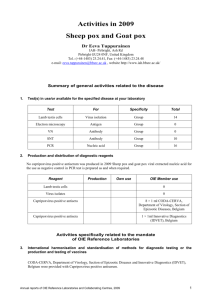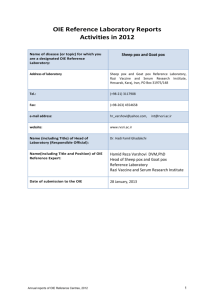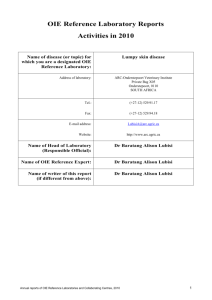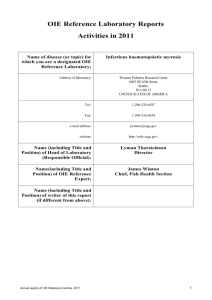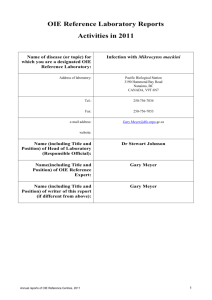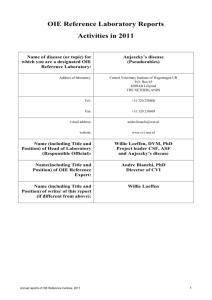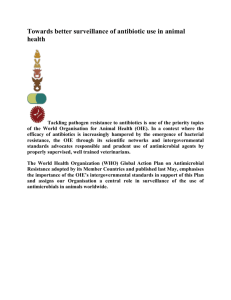MDBK/CFT cell culture
advertisement
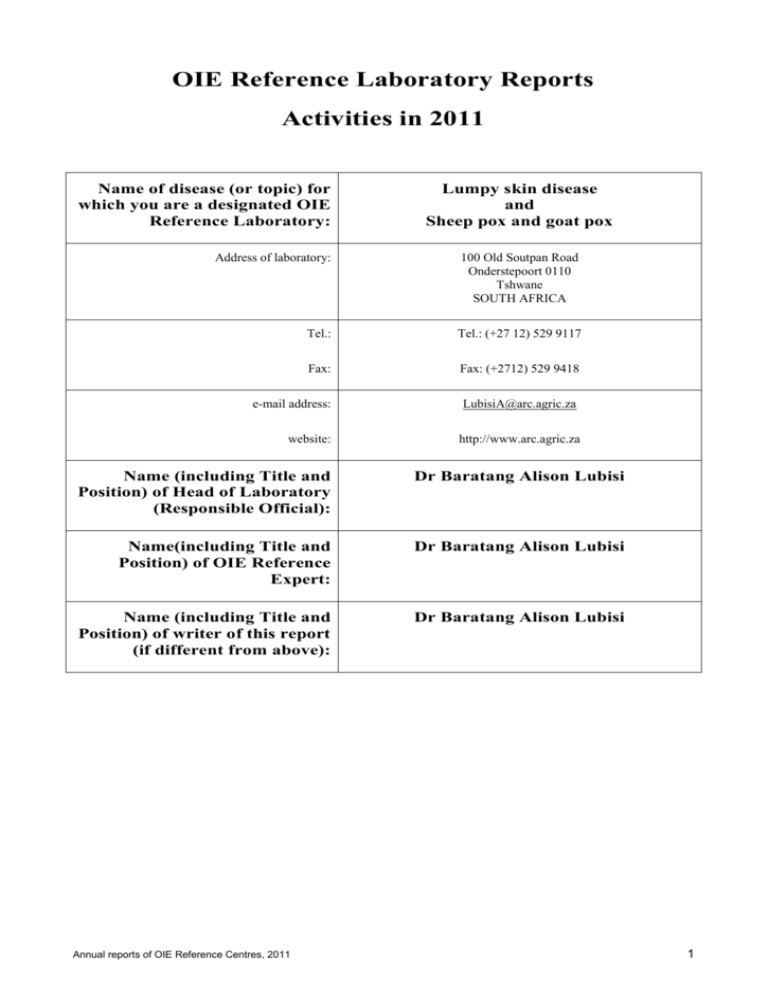
OIE Reference Laboratory Reports Activities in 2011 Name of disease (or topic) for which you are a designated OIE Reference Laboratory: Lumpy skin disease and Sheep pox and goat pox Address of laboratory: 100 Old Soutpan Road Onderstepoort 0110 Tshwane SOUTH AFRICA Tel.: Tel.: (+27 12) 529 9117 Fax: Fax: (+2712) 529 9418 e-mail address: LubisiA@arc.agric.za website: http://www.arc.agric.za Name (including Title and Position) of Head of Laboratory (Responsible Official): Dr Baratang Alison Lubisi Name(including Title and Position) of OIE Reference Expert: Dr Baratang Alison Lubisi Name (including Title and Position) of writer of this report (if different from above): Dr Baratang Alison Lubisi Annual reports of OIE Reference Centres, 2011 1 Lumpy skin disease and Sheep pox and goat pox Part I: Summary of general activities related to the disease The OIE Lumpy Skin Disease (LSD) reference laboratory at Onderstepoort Veterinary Institute (OVI) aligns its activities with the Agricultural Research Council’s (ARC) strategic objective related to enhancing the ability of the agricultural sector to manage and mitigate agricultural risks. Activities for the report period included the provision of diagnostic services; disease certification of ruminants for breeders and exporters of susceptible live animals; conducting serological tests for studies aimed at understanding the prevalence of the disease in certain geographical areas and vaccine quality assurance (Table 1); and performance of research aimed at improving the currently utilised diagnostic tests and vaccines. Among the animal species tested were eland, gemsbok, springbok, buffalo, giraffe, kudu, oryx, caprine and bovine. Table 1 Results for tests conducted on South African samples Province No. of specimens Positives/Test PCR SNT VI EM Gauteng 235 2/26 69/209 N/A N/A Limpopo 31 0/10 5/21 N/A N/A North West 362 1/3 28/359 N/A 2/2 Northern Cape 29 0/2 5/27 N/A N/A Kwa-Zulu Natal 14 0/0 0/14 N/A N/A Free State 239 14/86 14/150 0/3 5/5 Eastern Cape 18 0/0 0/16 0/2 1/1 Mpumalanga 4 1/1 0/2 1/1 N/A Western Cape 8 0/1 1/7 N/A N/A N/A – not applicable; Orf virus was identified by electron microscopy in 8 samples submitted from Free State (4/4); Limpopo (1/1); Eastern Cape (2/2); and Mpumalanga (1/1). 1. Test(s) in use/or available for the specified disease/topic at your laboratory Test For Specificity Total Serum Neutralisation (SN) Antibody Group 805 Electron Microscopy (EM) Virus Group 16 PCR Genomic material Group 129 MDBK/CFT cell culture Virus isolation Group Six submissions with varying numbers of specimens Diagnostics project leaders: Drs BA Lubisi – BVMCh.MSc (classical virological methods) and Marco Romito – BVSc.MSc (molecular based diagnostic tests).Mr John Putterill (MSc) is the activity leader for EM imaging using negative contrasting techniques (2-3% phosphor-tungstic acid (pH 6.2) or 1% aqueous uranyl acetate). 2 Annual reports of OIE Reference Centres, 2011 Lumpy skin disease and Sheep pox and goat pox 2. Production and distribution of diagnostic reagents Type of reagent Amount supplied nationally (including for own use) Amount supplied to other countries LSDV positive antiserum None 5ml LSDV antisera (5 ml) was prepared for Dr Joseph Hyera of Botswana National Veterinary Laboratory, Private Bag 0035, Gaborone, in December 2011. Part II: Activities specifically related to the mandate of OIE Reference Laboratories 3. International harmonisation and standardisation of methods for diagnostic testing or the production and testing of vaccines I. Participation in an International Proficiency Test Scheme a) Establishment and maintenance of a network with other OIE Reference Laboratories designated for the same pathogen or disease and organisation of regular inter-laboratory proficiency testing to ensure comparability of results ARC-OVI embarked on an inter-laboratory exercise with the Institute for Animal Health (IAH), Pirbright Laboratory, Ash Road, Pirbright, Woking, Surrey GU24 ONF, UK, in 2011. The exercise was aimed at comparing the performance of our LSD serum neutralisation test (SNT) with that of another reference laboratory for quality control purposes. Table 2 indicates the results obtained. Table 2 Results of the LSD inter-laboratory test between ARC-OVI and IAH, Pirbright conducted in October 2011 LSD sera samples SNT results Sample ID Sample Details IAH ARC - OVI A1 VN83, 21DPI, 070306 1:60 1:64 A2 VN84,34 DPI, 200306 1:120 1:64 A3 VN83, 15 DPI, 010306 Negative Negative A4 VN83, 34 DPI, 200306 1:120 1:8 A5 VN83, 0 DPI, 140206 Negative Negative A6 VN84, 21DPI, 070306 1:30 1:32 A7 VN83, 37 DPI, 230306 1:160 1:28 A8 VN84, 15 DPI, 010306 Negative Serum depleted Positive control LSD + cattle serum 2006, VN84, 37 DPI !:160 1:128 Negative control Cattle serum UK, VN84, prior to inoculation Negative Negative The tests results were in good agreement. In general, similar levels of antibody titres were detected by both institutions, despite the cells used by the IAH being lamb testis or bovine dermis, while OVI utilised Madin Darby Bovine Kidney cell lines. In addition, the first serum dilution at IAH was 1:5, while that at OVI was 1:4. Annual reports of OIE Reference Centres, 2011 3 Lumpy skin disease and Sheep pox and goat pox Nonetheless sample A4 which tested strongly positive at the IAH (1:120), tested weakly positive at OVI (1:8). The sample was collected from an experimentally infected animal, VN83, which showed severe clinical disease at 34 days post inoculation (DPI). Root cause analysis (RCA) at OVI has since revealed that protection was actually seen up to 1:64, but since one duplicate showed what seemed like cytopathic effect (CPE) at 1:16, but was clear (no CPE) at two consecutive dilutions, the analyst decided to report the titre as 1:8. The other duplicate clearly showed the titre to be 1:64, which compared well with the IAH results, given that one titre lower or higher is permissible in such tests. The serum was depleted and re-testing could not be done. b) Organisation of inter-laboratory proficiency testing with laboratories other than OIE Reference Laboratories for the same pathogens and diseases to ensure equivalence of results Not done. 4. Preparation and supply of international reference standards for diagnostic tests or vaccines Not done 5. Research and development of new procedures for diagnosis and control I. Improvement of lumpy skin disease virus (LSDV), both as a vaccine and a vector, by using recombinant knockout (KO) technology to remove putative immuno-modulatory genes. The four knockout recombinant viruses that were generated previously have been grown to high titre stocks for use in an upcoming animal trial (2012). Project leader: Dr David Wallace (PhD); co-worker: Mr Pravesh Kara(MSc) II. Determination of the binding in an invitro system (e.g. ELISA, dot blot) of the putative LSDV interferon gamma receptor-like protein (IFNγR) to bovine interferon gamma (IFN γ). To understand the effects of the putative immuno-modulatory genes encoded by LSDV on the host’s immune responses, a number of these genes have been selected for expression and functional assays. Open reading frame 008 (ORF008) has domains homologous to the receptor of IFN γ, an important cytokine in the defense against viral infection. Thus the binding capability of the putative LSDV IFNγR to bovine IFN γ is being studied. Vaccinia virus, other orthopoxviruses, capripoxvirus, myxomavirus and swinepox encode related proteins. The poxvirus receptor-like protein binds interferon γ thereby preventing the cytokine from binding to its cellular receptor, leading to moderated host immune responses. The putative LSDV IFNγR protein has been expressed in a bacterial system and purified. The protein is soluble and is now available for further evaluation. Project leader: Dr Arshad Mather (PhD); co-worker: Mr Pravesh Kara (MSc). III. Evaluation of a marker-free recombinant LSDV-vectored RVF vaccine The project on this construct is on-going. A single animal (sheep) trial was conducted late in 2011 using a primeboost regime. Results of sample testing and analysis are pending. Project leader: Dr David Wallace (PhD); co-worker: Busisiwe Khoza (NDiP) 6. Collection, analysis and dissemination of epizootiological data relevant to international disease control Not done. 4 Annual reports of OIE Reference Centres, 2011 Lumpy skin disease and Sheep pox and goat pox 7. Maintenance of a system of quality assurance, biosafety and biosecurity relevant to the pathogen and the disease concerned All diagnostic tests are performed by competent personnel; the laboratories engage in inter-laboratory tests, and verified control reagents are employed. Tests are performed in BSL2 laboratories in biohazard cabinets, and personnel wear protective clothing in addition to exercising good laboratory practice. Biological waste is autoclaved and incinerated. 8. Provision of consultant expertise to OIE or to OIE Member Countries Not done. 9. Provision of scientific and technical training to personnel from other OIE Member Countries Not done. 10. Provision of diagnostic testing facilities to other OIE Member Countries Country Namibia No. of specimens 24 Test Tentative Confirmatory Yes No No. Positive 4 Positive results reported to OIE N/A N/A - not applicable because the test conducted was not confirmatory, or if confirmatory, the results were negative 11. Organisation of international scientific meetings on behalf of OIE or other international bodies Not done. 12. Participation in international scientific collaborative studies Not done. 13. Publication and dissemination of information relevant to the work of OIE (including list of scientific publications, internet publishing activities, presentations at international conferences) Presentations at international conferences and meetings Not done. Scientific publications in peer-reviewed journals Not done. Other communications N/A _______________ Annual reports of OIE Reference Centres, 2011 5

